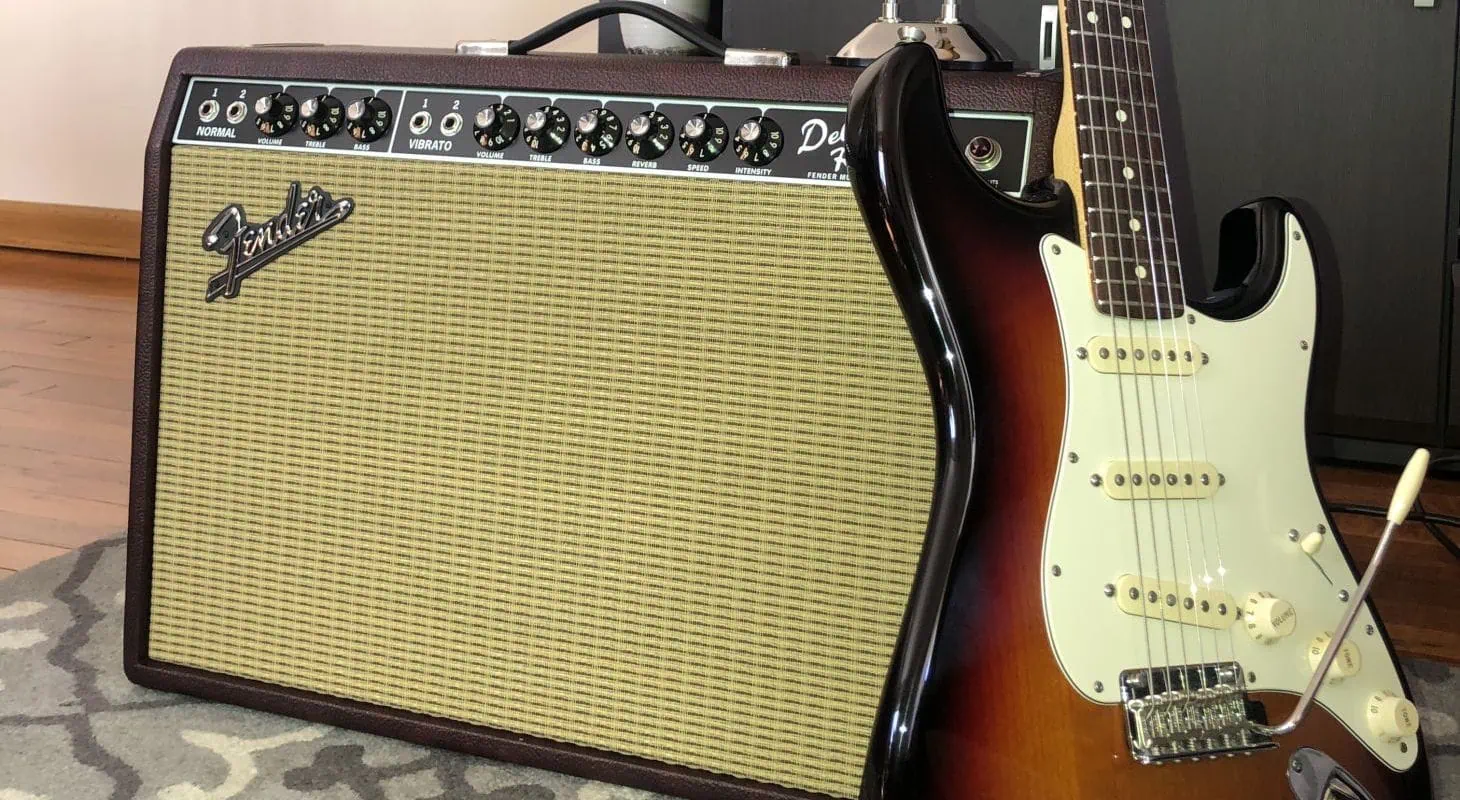Let me start this with a short story. I used to play in a band, and we gigged the underground alternative rock scene for about ten years. I’m talking about two to three gigs a week in pubs and small venues.
During those years, the idea of bringing our own amps on the road was utopia. You showed up, sound checked, and played with whatever was on stage.
It was then that I honed my chops, cut my teeth, and learned most of the secrets of being a guitarist on the road. One of those secrets is how to get all your tone from your pedals because you never know what you were plugging into.
Well, those adventures paid off with time. I learned a lot about what amps make the best pedal platforms to sculpt your tone, one pedal at the time.
So, I tried pouring all those years of experience into this post. You’ll read about what to look for in a pedal platform amp, why you need one, and what the best options in the market are right now.
By the end of the article, you’ll be ready to make an informed decision and buy the best amp for your needs and budget.
Are you ready? Let’s do it; it’s clean power time!
Why Do You Need a Good Pedal Platform Amp?
Which are the scenarios that might make you want to go for a clean pedal-platform amp instead of going for an amplifier with character, a couple of channels, and all the sounds you like?
Let me shed some light over the matter.
You Gig a Lot
If you gig a lot and you carry your amp around to every gig, you end up hating it. This is especially true if your amp is of a considerable size.
Believe me, I’ve carried my tube amp going up more than one stairway in my life and no, it’s not fun. Assemble a killer pedalboard and bring your pedal platform amp only when it’s comfortable and possible.
You Love Your Pedal Sound
We guitarists tend to love the way our gear sounds. This is especially true for those overdrive and distortion flavors. You just feel they’re part of your tone! It happens to me with my Tube Screamers and Big Muffs.
Well, if an amp has too much character, it will rob some of that tone and might even make it muddy. So, if you love your tone going through your pedals, a clean platform to push that forward is the best option.
You Have Volume Restrictions
We all love the way our valve amp sounds when slightly cranked and overdriving. That said, let’s face it, nowadays most venues won’t allow you to play that loud.
Getting that tasty broken sound with an overdrive pedal is the next best option, and for that, you need a clean pedal platform.
You Have Budget Constraints
Amps aren’t cheap. Yes, we tend to have multiple guitars and only one or two guitar amps, but they tend to be as (if not more) expensive as a good guitar. This is especially true for valve amps.
So, buying a clean amp that can take pedals well allows you to do some sonic exploration with pedals rather than with different amps. Budget-wise, this is a very smart move.
8 Best Clean Guitar Amps - Perfect for Pedals!
1. Roland JC-40
Roland’s Jazz Chorus amp has been going strong for almost 50 years now. From the original JC-120 to the JC-40 introduced for the amp’s 40th anniversary, you can find this amp on most stages around the world even today.
The JC-40 is a very well-built, solid amp. As you might know, solid-state technology needs less care when moving it around. You can hit it against the stool on stage and no glass will crack.
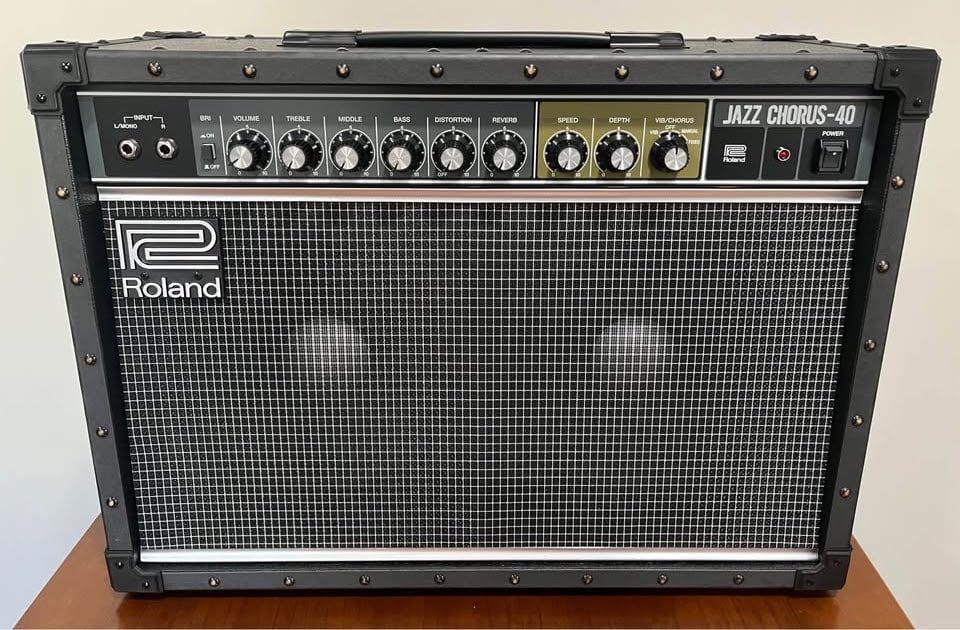
Roland JC-40
The JC series by Roland is, perhaps, the market benchmark for clean solid-state amps.
Well, it was also the one that started it all. The famous vibrato/chorus circuit in these amps was the first one ever made into a guitar pedal. Remember that Boss, part of the Roland Corporation, released the first chorus pedal (the Boss CE-1 came out in 1976).
It has all the features you would expect from an amp like this, with a few neat extras. The main feature being the vibrato/chorus effects.
But let’s talk about the knobs and features first. The EQ is very usable, especially to cut frequencies. I love the fact that you have that middle control because it allowed me to make my TS-9 shine through with that razor-like midrange and my Telecaster.
I had to roll the treble a little back and added some low-end for punch and warmth. This amp can be a little shrill or stale if you’re too used to playing valves. As a counterpart to that statement, the cleans are just pristine.
Moving over to the reverb control, Roland overhauled the entire circuit and it adds a nice ambience to whatever you play. Furthermore, mixing the reverb at around noon with the stereo chorus is a one-way ticket to psychedelia.
I went with my entire pedalboard into the stereo inputs and got my sounds mixed with the true stereo chorus. It was a mind-flipping experience, one of those setups you just can’t stop playing through. Especially with the delay ON and the Tele in the middle position.
The JC-40 is also a fully stereo amp. It features not just stereo output, but also stereo input and stereo effects loop. These can also be used in mono, giving the amp more versatility.
With such a great clean sound, it is no wonder that so many guitarists use the JC-120 and JC-40. From Pat Metheny to even Metallica. You can actually hear the JC-120’s clean tone in the intro of Metallica’s One.
A very iconic case of JC-120 users is Wes Borland from Limp Bizkit who plays Diezel and EVH heads for distortion but keeps cleans glassy through a pair of these in every live show.
The big difference between the JC-120 and the JC-40 is the speaker configuration. While the 120 carries two 12” speakers, the 40 carries two 10” speakers. This changes the way the midrange reacts, therefore, the sound of your guitar. I would say 10” speakers aren’t everyone’s cup of tea (that’s 12” speakers) but they have a great base sound for pedals.
Yes, the JC-40 handles effects pedals with ease. Furthermore, I didn’t find myself or the amp changing the sound of the pedals. It actually allows pedals to shine quite well.
This is also a good thing, because I am not too fond of the onboard distortion of the JC-40. Although the company overhauled the reverb and the distortion circuits, it’s still quite unusable. I mean, don’t get me wrong, the distortion is good and quite versatile, but it does become a bit sharp the higher you push it and is a nice add-on but not the reason to buy this amp.
So, if you like the overdriven, distorted, and fuzzed sound of your pedals, and want a great amp that’s reliable, sturdy, portable, and clean enough to see through it, this is a must check.
2. Supro 1968RK Keeley
Supro might not be the most well-known name in the amp industry, but they are by no means a small brand. Some of the biggest names in guitar play Supro amps like Joe Perry and Joe Walsh.
On the outside, the Supro 1968RK is nothing too fancy. It is fairly compact with very straightforward controls.
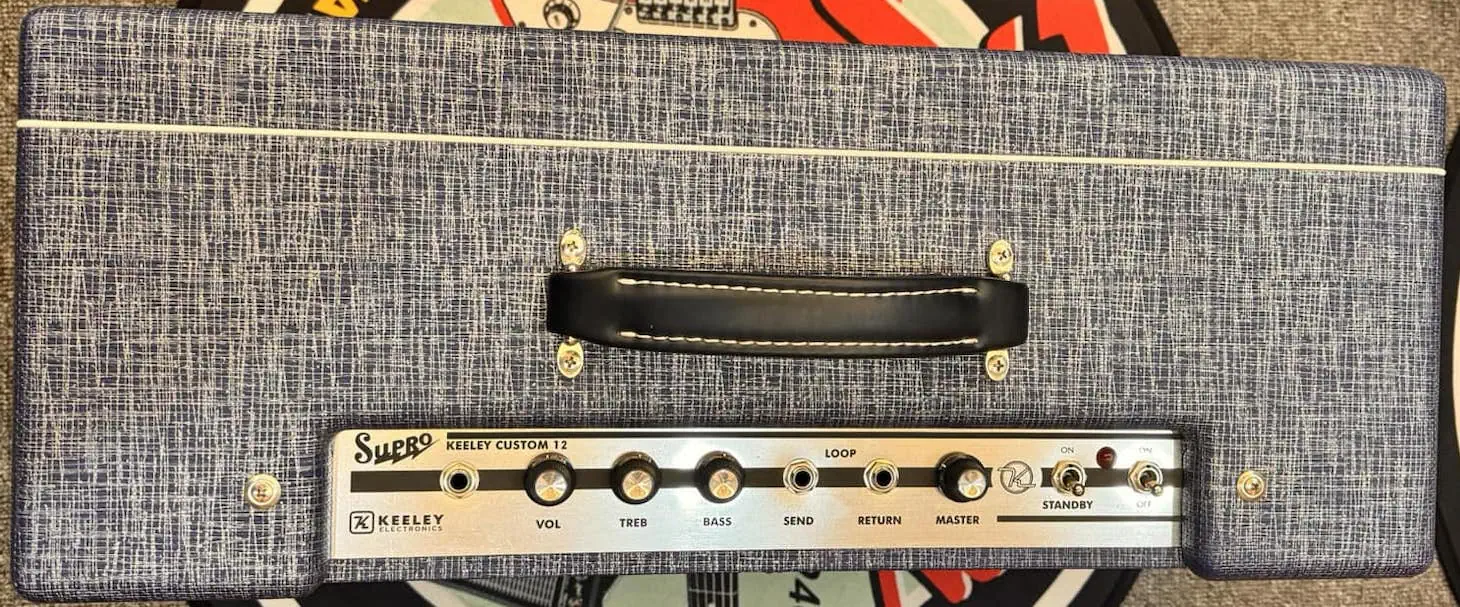
Supro 1968RK Keeley - Controls
It is a bit weightier than you would expect from such a small amp. But I wouldn’t call it heavy, it just feels solid. I can see myself carrying this amp to gigs and not being annoyed by it.
One thing that I also really like about this amp is its look. Supro has given it a nice light blue finish, instead of the standard black. This makes the amp stand out a bit more on stage. Furthermore, it would make a great addition to the furniture and ornaments of any living room or studio. Yes, it’s THAT good looking.
But looks or weight aren’t the reason this amp is so high up on this list. The thing is that this combo was developed by Supro and Robert Keeley, one of the most respected pedal makers in the world today.
If you look at what compressor pedal most pros use live, the Keeley in all its forms would be, perhaps, the most common one to appear.
So, these two companies joined forces to create the ultimate pedal platform amplifier. The result? Well, a terrific tool for the gigging musician and the studio player.
Let’s begin with the amp completely clean with no pedals. I have to say that, with my Telecaster plugged in, the sound of the amp was pristine. Supros are known for having a midrange snarl that’s beautifully complex and harmonically supercharged. Well, that’s not what you find here, this amplifier is as neutral as it gets without losing the warmth and tone you would expect from a tube amp.
The interplay between the volume and the master volume knobs is great and the amp stays clean with the volume up to 3 o’clock with single coils. This meant all my drive stages were singing through the 12” Celestion Creamback.
Also, the 2-band EQ proved to be very efficient in taming my guitar’s high-end and the low-end of my humbucker-equipped Ibanez Studio ‘80.
Since it’s only 25 watts, you can crank it and get some pushed tones out of it at a reasonable volume too. This means being able to compete with a loud drummer but also playing in your bedroom.
Speaking of humbuckers, things change drastically when you plug in a guitar with hot pickups. The volume knob becomes something closer to a gain or preamp knob like you would find on a JCM 800 for example. It was a very crisp, crunchy drive that kind of reminded me of The White Stripes’ Fell In Love With A Girl.
The traditional Supro snarl comes to surface and, combined with the TS-9, TS808, distortion, and fuzz, became a rocking beast ready to conquer the world.
Another aspect of this amp that’s very handy for live shows and pedals is the effects loop that’s easily accessible in the nice-and-polished silver panel.
I tried the Carbon Copy, the Strymmon FLINT, the MXR M95, and other modulation pedals through the input and also through the effects loop and results were drastically different but very usable in both scenarios.
The smoothness of the effects loop grants you instant trip hop and ambience music tones. I did a quite believable version of “Where The Streets Have No Name” and the delay and reverb tails were clean, crisp, and with the tube warmth you would expect from an amp like this.
So, in summary, the Supro 1968RK does exactly what it is advertised to do. It’s a terrific pedal platform that can take any and all pedals and also give you great tones on its own, both clean and cranked.
If this amp is within your budget, I urge you to check it out. It has headroom for days and tone to spare.
3. Vox AC30C2
The Vox AC30 is a true classic. It is one of the most famous amps that can be heard on albums from The Beatles to The Rolling Stones.
It is the definite sound of the British Invasion era. That gnarly, mid-infused overdrive comes with some brown tone that can make everything sound like a rock record from the ‘60s effortlessly.
The AC30C2 is a sort of redone, modernized version of the classic AC30. It brings the amp into the 21st century without sacrificing any of the classic tone.
If you have ever heard an AC15 or AC30, you know exactly what you are in for. The AC30 is that classic British rock tone. When comparing it to a USA-friendly kind of amp (mainly 6v6 power tubes instead of el84s as in this amp) what you hear is a very different overdrive grain and a different midrange.
While the USA-style can be defined as clear and sparkly with kind of a scooped sound, this amp is brown and defined with low-end punch and high-end clarity but a more raunchy mood.
Yes, the AC30C2 has a very crunchy gain with quite a lot of attitude. The gain is also quite crisp, even when you push it. It doesn’t become muddy or even really dirty.
If you are looking for that classic sound in the vein of The Rolling Stones or Led Zeppelin, the AC30C2 is really a great option.
Let’s start with the technical side. This amp has two channels and four inputs. You have the Normal channel and the Top Boost channel. As you might imagine, the second is more prone to distortion than the first.
That said, there’s a master section that allows you to control the overall volume. So, if you crank the first volume knob and leave the master low, what you have is low-volume crunch. Doing the opposite gives you generous crisp headroom to play with pedals.
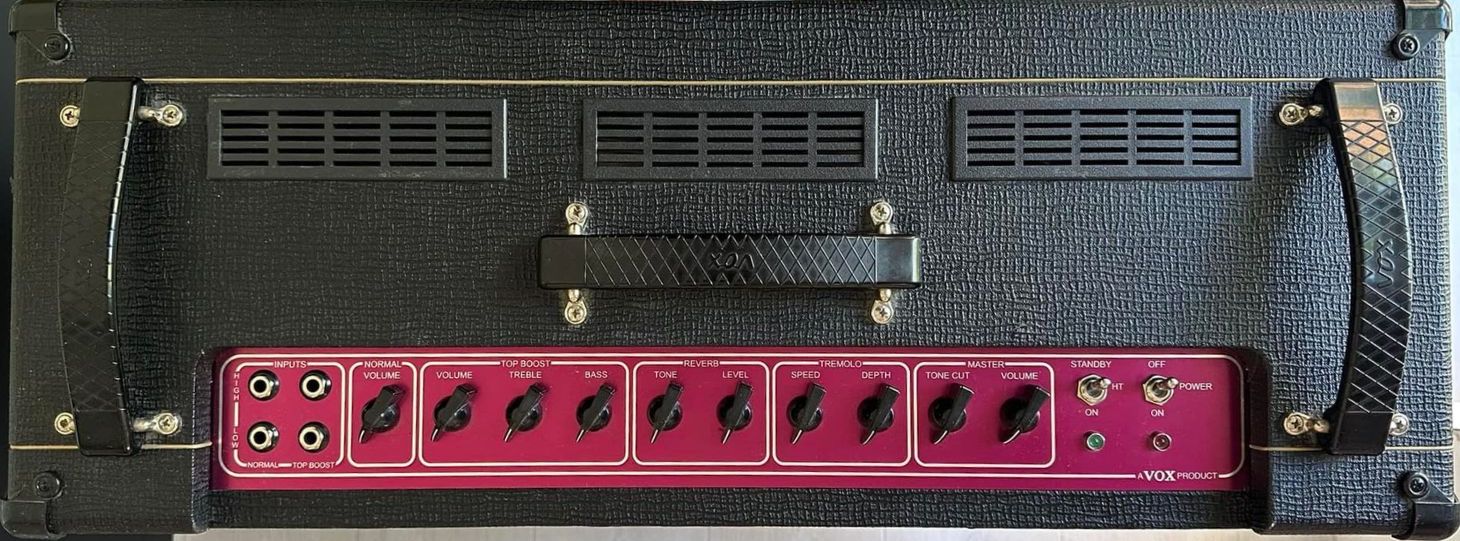
Vox AC30C2 - Controls
I did just that, plugging into the normal channel I was able to get that trademark The Edge sound with just the delay and the reverb. Furthermore, this amp packs delicious reverb and tremolo effects that can be activated via footswitch.
Again, my version of “Where The Streets Have No Name” was not perfect, but sounded outstanding through this amp.
In this setting I hit the amp’s preamp section with everything I got and went back and forth from single-coils to P-90s to humbuckers and the result was always punchy, clear, and powerful.
The AC30C2 isn’t by any means a small amp but it does pack enough power to stay clean when you’re playing to a loud drummer. Moreover, the tube circuit cleaned very nicely when rolling off the volume of my guitar.
Speaking of which, moving over to the top boost channel and using the pedals through the bypassable effects loop opened up a new sonic highway. Yes, I could set the amp to distortion and use the guitar’s controls to tame the beast and add color through pedals.
The effects loop takes away some of the grit from the pedals’ trails and makes everything more pristine. Although it’s not my favorite approach, I have to say that those who want pristine tones to play neo-soul or such genres will find this a great feature.
To say it one simple statement, the AC30’s clean tone is just as impressive as its overdriven tone.
I am always surprised by just how loud the AC30 is. It might just be a 30-watt amp, but it sounds like one that is four times as powerful.
Another thing that I am also always surprised by is how heavy this amp is. The AC30 is a hefty amp at 70 lbs. Let me just tell you that every ounce of that is pure tone at your fingertips.

Vox AC30C2
The AC30 is always an easy recommend regardless of the music you’re planning to make. It’s not easy to carry or light, but it makes up for that with tone and versatility for days. If it’s within your budget, you should consider it as a viable option.
4. Fender ’65 Deluxe Reverb
If the Vox AC30 represents the classic British rock tone, then the Fender ’65 Deluxe Reverb is the classic American rock sound.
The ’65 Deluxe Reverb has become a benchmark among guitarists and for good reason. It is such a well-designed amp that looks as iconic as it sounds.
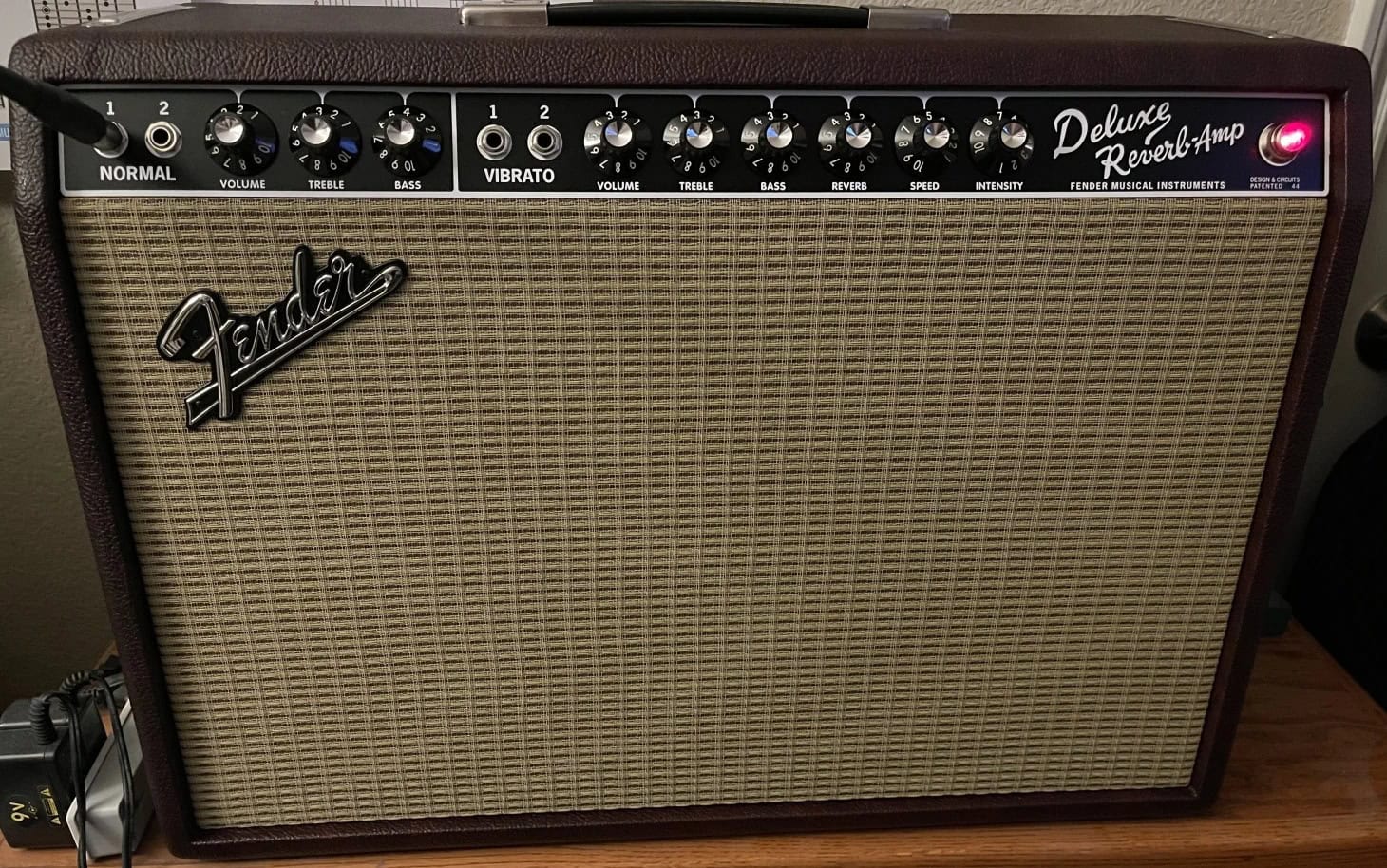
Fender '65 Deluxe Reverb
The Deluxe Reverb is, for many, the pinnacle of Fender amplifiers, the most perfect amplification machine to come out of the Big F factory. Well, not just the DR65, also its bigger sibling, the almighty Twin Reverb.
But why is the DR the perfect amp to play with or without pedals? I’ve had mine for a number of years and, although it’s primarily a studio amp for me, it gigs amazingly.
But let’s get the technicalities out of the way before going into the sounds.
The Deluxe Reverb 65 is the reissue of the famous Blackface era amplifier and it copies that circuit to perfection. Furthermore, a big difference between this amp and much of its competition (including the Supro 1968RK) is that it has valve-driven rectification.
What does it mean? Well, it means the amp’s overdrive and natural crunch are on a different level, a different plateau. It sounds more harmonically complex but as clear and articulate as it gets.
The two channels, normal and vibrato, work with different voicings. While the first is a tad darker, the second is brighter. Moreover, the reverb and tremolo with their tube circuits are stellar additions to an already outstanding package.
I always jump the channels, this means I use an interpedal cable to go from the normal to the vibrato channel and that’s where I plug my guitar. This way, you get some leakage and whichever volume is higher is the channel that dominates the sound.
While some might miss the middle control missing from the two-band EQ, my answer is: Tube Screamer. The clean of the amp is so full and clear that you don’t miss the midrange at all. That said, if you push the amp a bit going above 5, you get this natural, organic, touch-sensitive mild overdrive that’s just perfect for crunchy rhythms and blues.
The particularity of the Deluxe Reverb is that it stays articulate and clear even when you throw tons of gain on its (black) face. I’ve played gigs in which I had a TS-9, a Tech21 Double Drive, and a Big Muff Pi going at the same time and I could hear everything I was playing.
With no effects loop, there’s no way to get your time-based and modulation effects between the pre and the power amp. That might be a drawback for some who need synthetic-sounding, ultra-clean tones.
Well, the organic quality of the Deluxe Reverb’s sound makes up for the lack of an effects loop in my opinion. Furthermore, it’s one of those strange cases in which the amp’s tone blends in with the pedals. It doesn’t change the pedal’s sound and pedals don’t make the amp muddy or make it lose its clarity and articulation.
Finally, if you dime the volume control and play with a humbucker-equipped guitar, you’ll get this creamy, organic, naturally-compressed distortion that just begs for a Carbon Copy and a minor scale to rip the night away.
It’s hard to come back from that journey, you’ve been warned.
If this amp is within your budget, trying before buying is a must.
For a much more in-depth coverage of this amp, you can read this article, also written by me.
5. Fender Hot Rod Series
The Fender Hot Rod Series is made of 5 amplifiers. From small to big, the Pro Junior, the Blues Junior, the Hot Rod Deluxe, the Blues Deluxe, and the Hot Rod Deville.
These amps are a standard in the music industry, especially for playing live. It’s not unusual to walk into a venue and find one (or more) of them on stage. But that’s not reason enough to make it to this illustrious list. I agree. The thing is that they’re fantastic gigging amps.
I’ve played through many, many of them in all sorts of states, from neat and new to those that have fought one too many battles in their life. But the clean you can get from the Deluxe and Deville as you lower the volume and increase the master make them perfect pedal platforms.
It’s the non-HD version of the DR65 because they’re not as defined and articulate. That said, they sound great with all kinds of pedals and do a great job at staying off the muddy frequencies in the spectrum.
I have to make a distinction here, though. The Blues Deluxe is not as versatile as the Hot Rod Deluxe (and here's our detailed comparison between them).
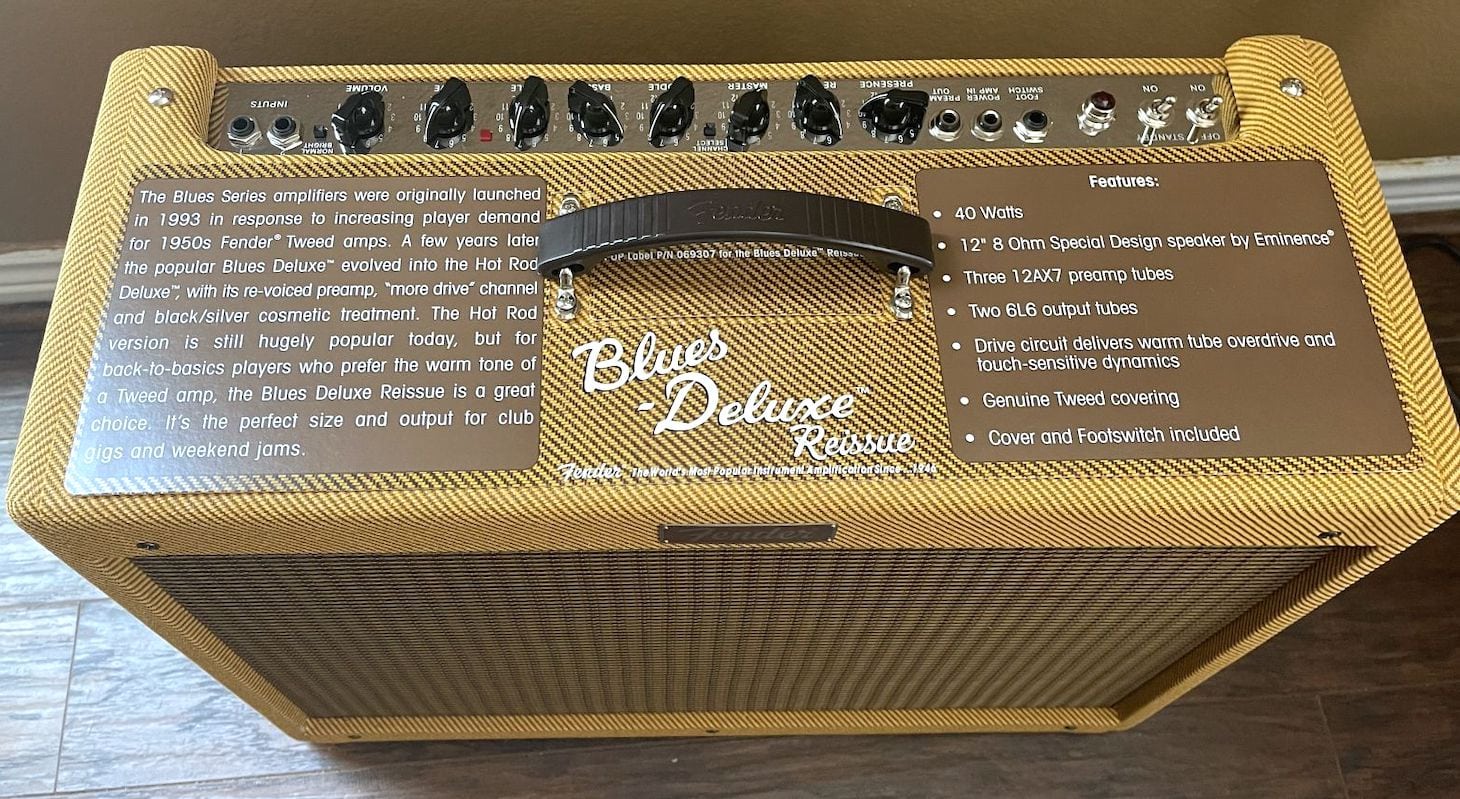
Fender Blues Deluxe
Yes, it has a dark, massive clean tone that’s bluesy and drips coolness all over. The thing is if you intend to fuzz it out or add a lot of distortion to the signal, it can’t cope with those tones the way the rest of the line can.
So, the Pro Junior and Blues Junior are great for small-sized venues. They pack 15 watts of valve power but have no master volume. So, if you crank them to compete with the drummer, some of that cleanness will be gone.
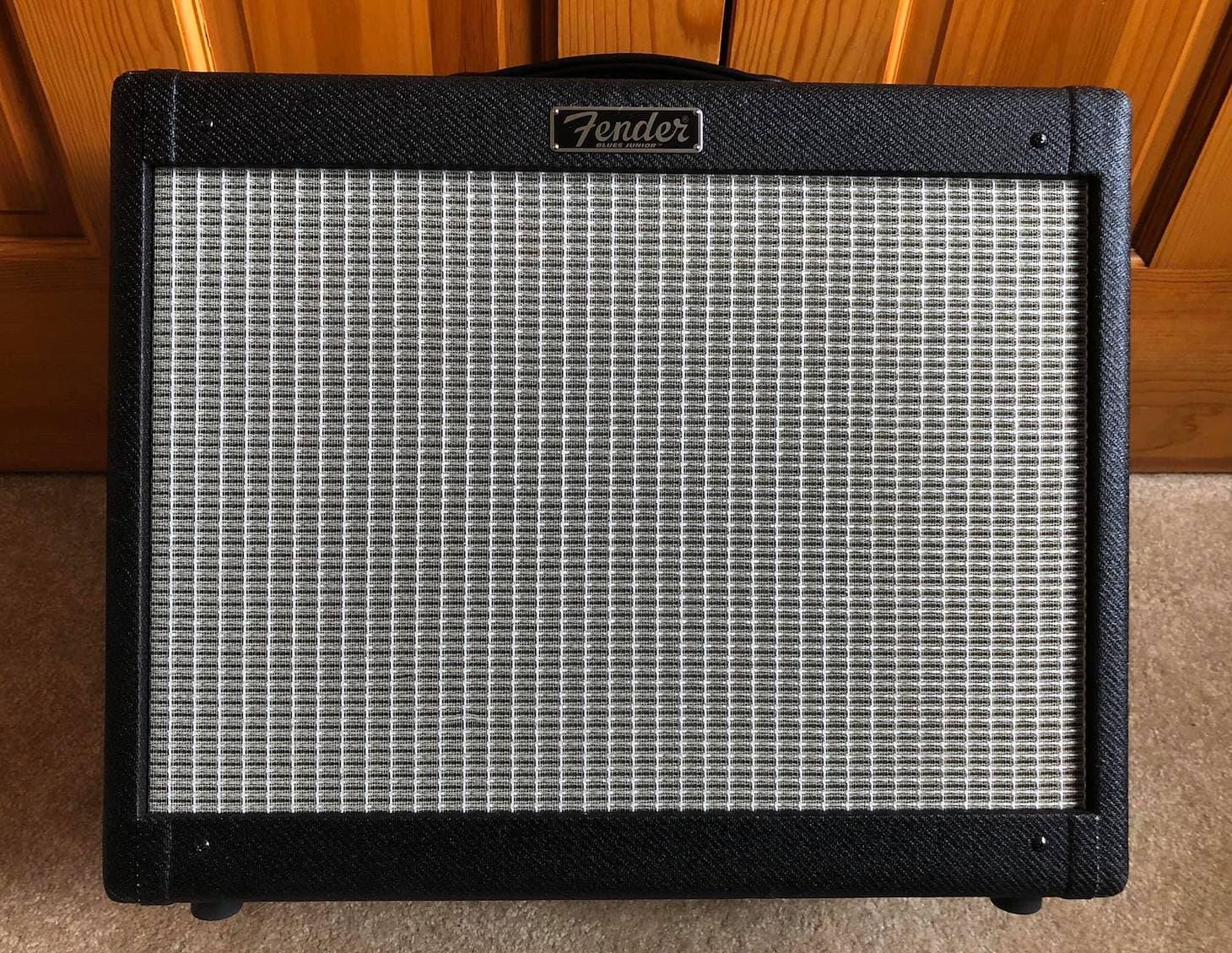
Fender Blues Junior IV - Closer Look
That said, gigs with no drummer that allow you to keep the volume tamed are perfect for these amps. You can carry them up the stairs with one hand!
For medium to large-sized venues, what you need is a Hot Rod Deluxe. It’s a sturdy, well-made amp with a lightweight pine cabinet that makes it lighter than most amps out there. The dual footswitchable channels and the easily accessible, top-mounted effects loop allow you to carry only your time-based and modulation pedals if you want.
Furthermore, at 40 watts the Hot Rod Deluxe gives you enough headroom to play with pedals and is usable at a moderate volume to get tube saturation.
For bigger venues or more headroom, the 2x12 Celestion-equipped Hot Rod Deville delivers 60 watts of clean power with footswitchable channels and front-mounted effects loop.
There’s a Hot Rod amplifier for every budget and size, so try them out and get the one that suits your sound the most.
6. Boss Katana Gen 3
Most guitarists might look down on modeling amps, but Boss has proven that they are more than just gimmicks with their Katana series. The series is made of three amplifiers, the Katana 50, the Katana 100, and the Katana Artist.
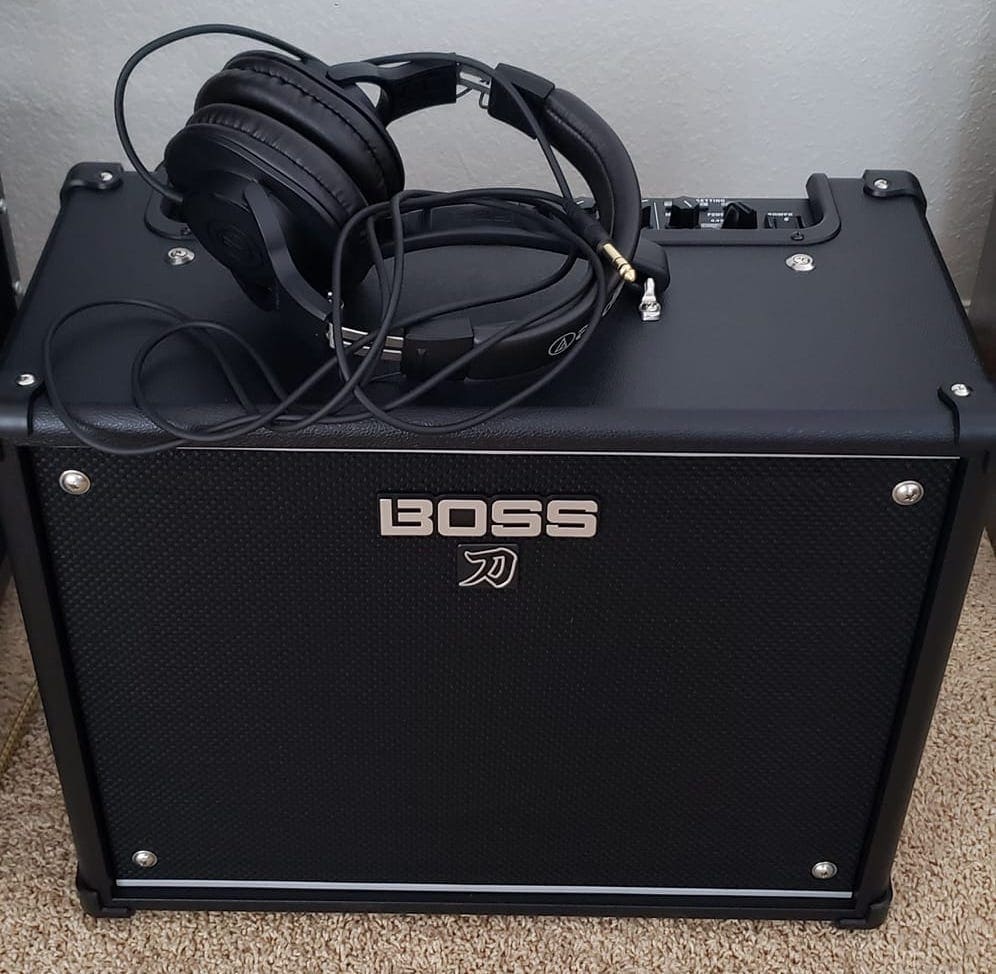
Boss Katana 50 Gen 3 and my Audio-Technica cans which I often use for practice sessions.
Modeling amps have come a long way since first being introduced. The sounds they emulate are much closer to the original than they were starting out. Most of them no longer have that artificial high-end that became shrill and punishing with single-coil guitars.
Plus, the one thing that Boss is known for is making world-class pedals that can be found at the feet of anyone from bedroom hobbyists to worldwide stars like John Frusciante and Dave Navarro.
So, they designed a great pedal platform that worked perfectly for their own customers, Boss pedal customers.
To begin with, with the Katana series you are able to get almost any amp sound you can think of. From a classic British rock tone, to a vintage blues, and even modern metal. What I did first was create a preset with the clean model. The sound was pristine enough to work as a pedal platform. I just dialed in a little reverb and then plugged the entire pedalboard in front of the amp.
The results were surprisingly good. I mean, the amp took the drive stages as well as the time-based and modulation effects perfectly. Here I have to make a distinction, only the 100-watt models have an effects loop, the Katana 50 doesn’t feature one.

Boss Katana 50 Gen 3 - Controls
I threw everything I had at it with all the gain stages, the delay and the phaser to try and make it muddy and bad, but the amp stayed clean and understandable all the time. Yes, it doesn’t sound as warm, round, percussive, and articulate as the valve amps on this list, but it’s a usable, modern, pristine sound that works great as a pedal platform.
What I tried after the effects loop was the power reduction and it worked perfectly well to have wild sounds at bedroom volume. But what surprised me the most about this amp was blending the overdriven and distorted sounds within the amp’s modeling stage with the pedals on my board.
I was pleasantly surprised to know all models in the wheel blended in so well with pedals.
Since the Katana sounds are also controlled through software, you can easily tweak the onboard sounds or even replace them entirely.
I know what you’re thinking, there’s a huge selection of effects, both onboard and with the software available in this amp; why would you put pedals in front of it? The Katana is essentially one big pedalboard built into an amp.
That’s exactly what sets this amp apart from the rest of the modelers out there, analog effects sound just as great as they would on a tube amp or normal solid state. You aren’t losing any tone on your effects pedals when they go through this amp.
So, if the pedalboard breaks down, or you have no room for pedals, you can just create some usable banks and cover most of your material. Therefore, the Katana series by Boss offers a great solution for the gigging guitarist (especially the Artist with the balanced DI out with ground lift) who loves to play through analog pedals while enjoying the practicality and weight of a digital amp.
If you play in multiple bands in different genres, or you play in a cover band, this is the perfect amp. You can get sounds for every song, no matter the genre.
Regardless of your personal opinion about modeling amplifiers, do yourself a favor and try a Katana out, they’re great pieces of gear.
Further reading: BOSS Katana vs Positive Grid Spark (a much more in-depth take on the Katana, and comparison with the newer Spark amp from Positive Grid)
7. Marshall DSL40CR
Closing your eyes and thinking of Marshall will automatically take you to some of the most iconic moments in rock history. Marshall is one of the foundational stones of modern music, powering the sound of players from Van Halen to John Frusciante into screaming fans.
It was through John Frusciante that I ended up in this realm of Marshall clean sound. He plays his cleans through a Marshall Major, a sixties 200-watt tube beast that remains clean at deafening volume. But the spanking midrange that separates Marshall from all the US-made amps is right there. It’s the percussive sound Hendrix came up with and John perfected.
Well, I tried it first with a Marshall Origin 50, an honorary mention on this list, and it sounded great but was harder to get a clean sound to play at band level. The DSL40CR, on the other hand, gave me enough headroom to put my pedalboard through it.
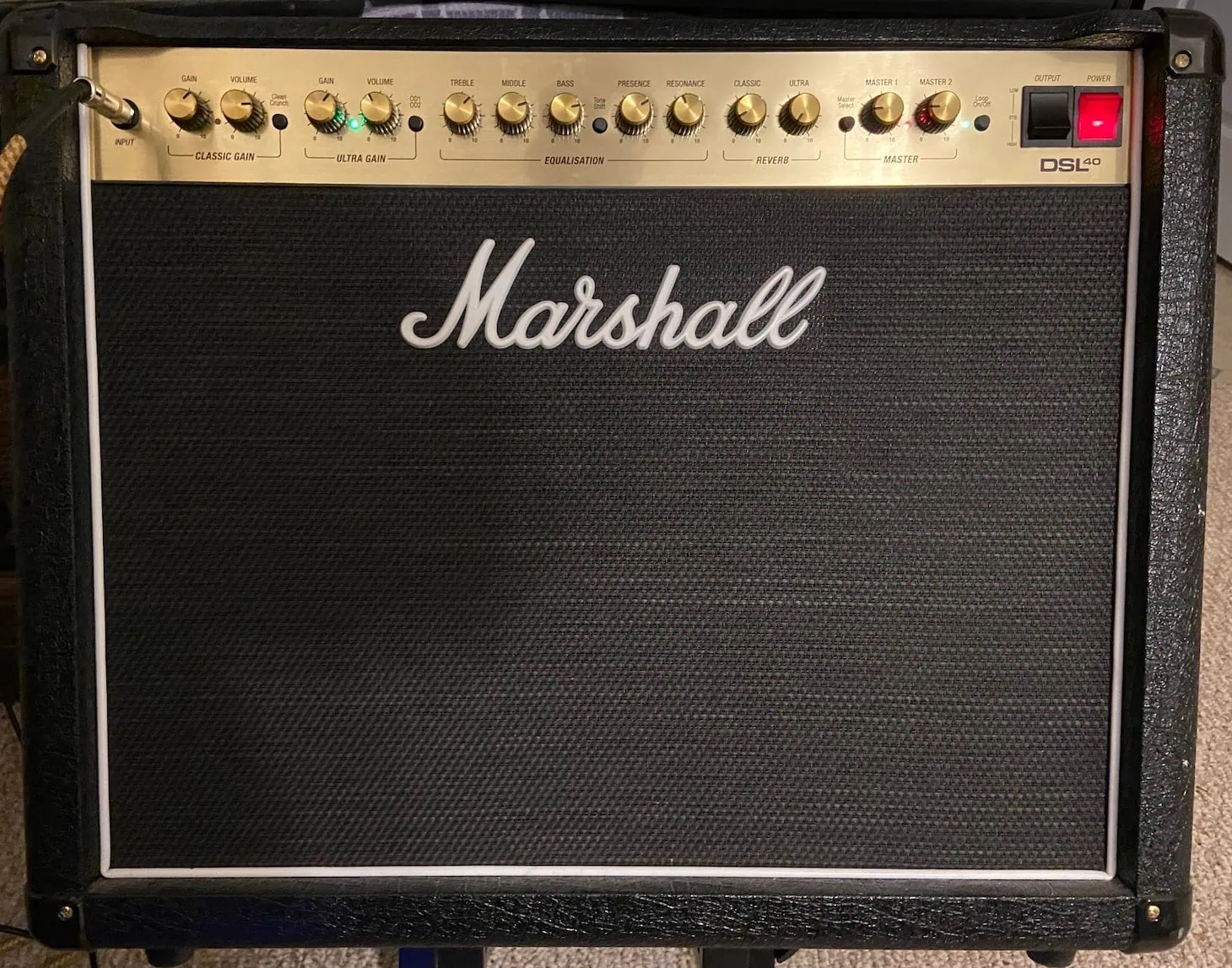
Marshall DSL40CR
Furthermore, what I did with great results was pushing the amp’s front end with some overdrive and adding the crunch and ultra distortion to the sound. What I got was a cascade of gain with different stages to choose from. I especially loved my TS808 going straight into it, making the low-end tighter and giving the midrange more edge.
Also, since this amp has an effects loop, using all that gain and running your delay through it keeps repetitions clean and adds another layer to your playing without making the sound muddy.
Furthermore, the effects loop is footswitchable from the included pedal, so you can bring it in and out of the mix whenever you want. This is also a great way to activate several pedals at once with a single switch.
I tried this amp with single coils, P-90s, dusted off my mini-humbucker guitar, and also plugged in some humbuckers. The single-coil and P-90 guitars shone through with enough bite to tear the fabric of reality. Getting into dual-coil territory, and mixing in-amp gain stages with pedals made things a little muddy.
Finally, the built-in power attenuator helped me get some real Led Zeppelin-like tones at bedroom volume easily.
Although it’s not such a lightweight amp at 50 lbs. It’s a great all-in-one solution for the gigging musician.
8. EVH 5150 Iconic Series 40-watt
Any brand carrying Eddie Van Halen’s name has a lot to live up to. EVH amps are exactly that and then some more. They’re well-built, fantastic sounding, and very versatile as you’ll find out in a few lines. The EVH 5150 Iconic has become one of my favorite amps.
I really like the clean design of the 5150. It pays homage to the no-thrills look of the original Peavey 5150 but with some fancier appointments borrowed from Marshall like the golden stripe around the mesh cloth.
Indeed, it's Peavey meets Vox, meets Marshall; if that makes any sense.

EVH 5150 Iconic Combo Amp next to a Gibson Les Paul Classic.
All of the controls are at the top of the amp in this iconic series, bringing them closer to the original and moving away from the 5150 III front-mounted controls.
The 5150 has quite a bit more controls than you will usually find on a 40-watt amp, but don’t let that intimidate you, it’s a straightforward configuration that makes it an easy-to-use pedal platform.
The crucial aspect in that regard is that this amp has two channels, with independent gain and volume controls. This allows you to dial a very clean side to use with all your pedals and combine them with the utterly-distorted, face-melting, mayhem-causing distortion of this amp. Yes, the gain seems endless and there’s tone and sustain for days.
So, with the footswitch, you can have the best of both worlds.
But that’s not all, because you also have a very usable effects loop to send all your modulation and time-based units. For example, I did the good-old TS-9-in-front trick and suddenly, the distortion became tighter and the midrange turned sharp enough to cut through any mix. With a little Carbon Copy in the effects loop, I was shredding the night away in no time.
Also, one thing I do a lot is to cause mayhem with fuzz and use distortion for power chords and defined riffing. If you go from distortion to fuzz, the effect is as if you’ve unleashed chaos. I did it with this amp going from the distortion channel in the amp to the clean and hitting the fuzz. The result was a big wave of sound crushing everything around.
The best of it all is that the amp’s speaker and preamp section didn’t even notice and handled the low-end marvelously. Furthermore, I threw an octave pedal over the fuzz and I stepped on Jack White’s feet for a moment.
The amp remained consistent and tight throughout the test.
Also, the direct XLR out is a great addition for the gigging musician who wants to have a great sound on stage and some reliable source for the soundman or the band’s in-ear monitoring.
Going back to the amp’s controls, it sports a three-band EQ, and reverb with controls for resonance and presence. The 5150 also has a boost for when you want to give it an extra push. And most interestingly, it also has a noise gate for the second channel.
Two channels, both with independent gain and volume controls, a three-band EQ, and reverb with controls for resonance and presence. The 5150 also has a boost for when you want to give the amp an extra push. And most interestingly, it also has a noise gate for the second channel.
This amp gets loud and mean. It's not hard to see why this amp is a favorite of guitar legends like Buckethead and bands like Gojira.
On channel one, you have a very nice crunch which can get quite aggressive when you push the gain far enough.
Channel two is the lead channel which pushes the distortion further. This is where the amp is especially true to the EVH name. The amp sounds like something Van Halen himself would have played.
The 5150 is just an incredibly fun amp overall. Whether you are using it as is or putting a pedalboard in front of it, or both, you are going to have a ton of fun with it.
Choosing the Best Amp for Clean Tones
While technically pedals work with pretty much any amp, not every amp will give you the same experience. Some amps will perform better with pedals than others. There are a few things that can influence this.
This is what you should look at when shopping for a new pedal-platform amp.
Headroom & Power Rating
You might have heard people mention the word headroom when they are talking about amps, but what exactly is it?
Headroom refers to how loud an amp can get before it starts to break up. I know what you’re thinking and you’re absolutely right, not everyone thinks break up tone is the same. Well, it’s a guitarists’ consensus that natural overdrive is an amp’s headroom volume ceiling.
The more headroom an amp has, the better it will perform with pedals. This is because you will be able to push the volume on the amp more before it distorts and make the most out of your pedals.
This is especially true with overdrive and distortion pedals. If an amp has too much character and breaks up too fast, you won’t be able to use your favorite overdrive pedal because as soon as you turn it on, you’re in distortion mode.
How is this related to power ratings? Well, a good example could be the small valve amps at 5 watts or the small solid-state amps at 10 watts. They won’t be able to handle pedals and stay clean at a decent volume (or sometimes at any volume).
In other words, when you are using pedals, you want the sound to be coming mostly from the pedals. The natural overdrive can interfere with the sound of the pedals.
The headroom of an amp is also a double-sided blade because, especially in valve amps, it also means “bigger and heavier” (remember power ratings).
For example, you won’t get more clean headroom than playing with a Twin Reverb, rated at 85 watts, but 99% of the time you’ll leave it at home because it’s just “too big and heavy”. The Deluxe Reverb stays fairly clean at band volume and is much more gig-friendly at 22 watts and with a considerably smaller size.
So, the examples above have enough headroom to be usable at gig volume at an ideal weight-size ratio.
Solid State vs Tube
The two types of amps, solid state and tube, perform differently with pedals. Tube amps have a more natural sound.
Solid state amps aren’t quite as natural sounding as tube amps. Modern solid state amps are closer in tone to tube amps but there’s still an undeniable difference that you not only hear, but mostly feel in your hands as you play; valves react differently. That said, both make great pedal platforms.
The power rating also differs quite a bit between solid state and tube amps. Solid state amps don’t have a 1:1 comparison with tube amps when it comes to power rating.
A 50-watt tube amp is going to be much louder than a 50-watt solid state amp. This ties back into headroom.
As I mentioned, an amp with more power is going to have more headroom. So, a 50-watt solid state amp is also going to have less headroom than a 50-watt tube amp.
Effects Loop
The effects loop allows you to place effects after the amp’s preamp.
The reason you would want to do this is because certain effects sound better when they are placed after the distortion. For example, all time-based effects like reverb, delay, and also modulation effects sound better when placed after the preamp section of the amp.
Some amps have a switchable effects loop, which can be handy when playing live too.
A Different Approach, Pedalboard Amps
From the huge Blackstar AMPED 2 to the tiny Tone X, the proliferation of pedal-sized amp emulators in the last years has been meteoric.
But what do these pedals do? Well, we could divide them into two categories.
On one hand, you have amp emulators that digitally emulate the preamp and power amp sections of legendary amplifiers and how they would behave and sound. By doing so, they act like real amplifiers and can be your only companion on the road given there’s a PA to plug into. In other words, they can’t power a cabinet or generate real volume.
On the other hand, pedals like the Blackstar AMPED 2, are complete amplifiers with a power section that can be hooked up to a guitar cabinet. In the case of the Blackstar it boasts 100 watts of pure guitar tone in 3 channels. Other approaches can be the tiny Electro-Harmonix 44 Magnum, a 44-watt guitar amplifier pedal in the size of the brand’s famous nano enclosure.
In case you’re wondering if you can plug a Tone X into the Magnum and gig with just that and a cabinet, the answer is absolutely yes.
For example, I put together a solo rig to play with loops and bought the utterly inexpensive NUX Optima Air, and loaded a Deluxe Reverb IR to it. I use it last in the chain before going out to the PA and I can toggle between a great-sounding acoustic IR and the DR IR and it all sounds great.
Yes, it gets all the sounds from my pedalboard, overdrives, distortions, fuzzes, octave pedals, and more.
Although it doesn’t feel the same, it sounds very realistic. I won’t be carrying amps to that kind of show anymore, but I still want an amp when playing in a rock band.
Closing Thoughts
Pedal-platform amps are a great tool for any gigging musician.
Whether they’re your base to sculpt your tone in different directions for different projects, or because they help you get THAT pedal sound, the amps on the list are reliable, great-sounding units that can get the job done night after night.
There’s an amp for every budget and taste, from legendary valve tones to modern tube amps to solid-state legends to modeling units, the choice is entirely yours.
Did I miss any important amps? Do you agree with my choices? Let me know in the comments below.
Now go get your pedals and play some music; life’s too short to be too much time without a guitar in your hands.
Happy (clean and loud) playing!
